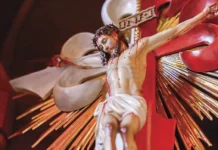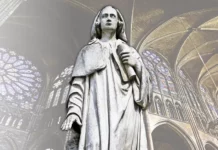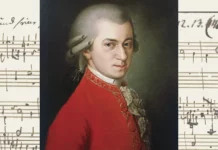The symbols used on altars for the Holy Mass are not merely decorative objects, but representations of a mysterious reality in which we are called to participate through the Sacred Liturgy.
From the earliest times of history, man has sought to peer into a world shrouded in mystery, where a Divinity worthy of reverence would be found. They felt the need to worship God, but they did so imperfectly, for they sought the Creator by trying to “feel after Him” (Acts 7:27).
In the fullness of time, Our Lord Jesus Christ came to dwell among the children of Adam and give himself as a sacrifice to open the doors of Heaven to them. In all His actions, words and prayers, the Lamb without blemish offered as a Man what He deserved as God: perfect praise.
This praise, however, did not end with His Ascension into Heaven, but continues intact and perennial in the Sacred Liturgy through which Christ himself “is ever living in His Church. Here He continues that journey of immense mercy which He lovingly began in His mortal life.”1
What are the significations surrounding the gestures and words of the Good Jesus, reproduced by Holy Mother Church in the Sacred Liturgy?
This is the theme that we wish to develop in this article, based on a symbolic vision of the ornaments that cover the altars for the Holy Mass: the cloth, the cross, the candles and the flowers.
Shroud enveloping the Body of Christ
On all the altars prepared for Holy Mass, a very fine white cloth is placed, a memorial of the “Shroud and other linen with which the Body of the Saviour, represented by the altar, was wrapped.”2
The first Christians already had the custom of covering the table of the celebration with a cloth, a custom they probably inherited from the Romans. However, around the eighth century, devotion and zeal for the Blessed Sacrament inspired the Church to use not just one, but two or more altar cloths. “It was during this period that the upper cloth, upon which the Body of Christ would be placed, came to be called a palla corporalis, or simply corporal”3 and began to take the form we know today.
Owing to its proximity to the Blessed Sacrament, the corporal became a greater object of veneration than the relics of the Saints. During the Middle Ages, it was reputed to possess a superhuman efficacy against fire and disease. And in many churches the priest went to the faithful after Mass to touch their faces with the corporal in order to protect them from ocular illnesses.
In addition to the Shroud and other cloths from the Saviour’s sepulchre, the altar cloths symbolize the members of the Church who surround the Supreme Risen King, like precious garments, as the Psalm sings: “The Lord reigns; He is robed in majesty” (Ps 93:1). The members of the Mystical Body spread throughout the world are the garments in which Christ is pleased to clothe himself!
The tree of life in the centre of Paradise
During Holy Mass a crucifix is placed before the priest, usually on the altar, to highlight the union between this act and the Holocaust of Christ on Calvary. There is only one Sacrifice of Christ, renewed by His ministers at each Eucharistic Celebration.
Although it is uncertain at what time this practice became official throughout the world, some Eastern rites had adopted it as early as the fifth century. In the West, however, the custom arose later: only around the eleventh century did it become common in the churches of the Latin Rite. The presence of this religious object during the celebration of Mass probably had its origin in the crosses which preceded the seasonal processions, the shaft of which could be removed, allowing them to be placed upright on the altar.
Analysing the meaning of this insignia in celebrations versus populum, Benedict XVI states: “The altar cross is not an obstacle to one’s vision, but the common point of reference. […] It is, for all, the image that converges and unites the gazes. […] Thus the difference between the Liturgy of the Word and the Canon becomes clear. While the first is preaching and, consequently, direct attention, the second is common adoration in which, today as yesterday, we pray: conversi ad Dominum, turning to the Lord.”4

The Sacred Liturgy also incorporates the symbolism bequeathed by the Fathers of the Church: the analogy between the wood of the Cross and the tree from whose fruit our first parents ate, and which merited their expulsion from earthly Paradise.
From one tree a curse fell upon disobedient man, but from another incomparably more beautiful Wood, God made remission of sins and salvation sprout forth. The Cross is therefore the source of eternal life which flows superabundantly in the Holy Eucharist, and the true tree of life of which the Book of Revelation speaks: “To him who conquers I will grant to eat of the tree of life, which is in the Paradise of God” (2:7).
Light that illuminates the whole world
Flanking the crucifix, the candlesticks and candles adorn the altars with a discreet, solemn and flickering light. Far beyond the practical reason of illumination, the Holy Church sees in these simple objects “the image of Him who is Light from Light, the Light of the world, the Sun of Justice, Jesus Christ.”5
In the discreet flames that illuminate the altars are represented “His luminous words, His redeeming grace and His love consummated in the Sacrifice of Calvary.”6
Seen from another perspective – no less beautiful and profound – candles symbolize our faith, our hope and our love, the virtues that guide us to the light of glory of the heavenly Church, which “has no need of sun or moon to shine upon it, for the glory of God is its light, and its lamp is the Lamb” (Rev 21:23).
Regarding their history, we know that only “in the first half of the eleventh century, did candlesticks begin to be placed on the altar.”7 Previously, they were normally arranged on the ground in front of the altar.
A unique symbol of the glory of the Crucified God
Beautiful for its variety, delicacy and simplicity, plant nature also glorifies the Redeemer with its dazzling colours and delicate fragrances.
Following a “very ancient tradition of the Church,”8 Christians provide roses and lilies to adorn the altars, symbolizing joy and “the good odour of virtues, of which the Divine Redeemer, represented by the altar, is the dispenser.”9
It was the custom of the ancients to decorate tombs of the deceased with flowers, and this custom was piously carried into the churches, whose altars served as reliquaries for the relics of the martyrs.
On the other hand, the Church finds in rose petals an “expressive symbol of the tongues of fire and of the gifts of the Holy Spirit,”10 which is why the Solemnity of Pentecost in Italy is called Pasqua Rosata – Easter of Roses.
And in more northerly regions, where there were no palms to celebrate Palm Sunday, flowers took their place to glorify the royalty of Our Saviour and exalt Him as the Victor of all ages.
Nothing appears in the Church in an artificial fashion
In analysing these aspects of the history of the Liturgy, it is edifying to observe how the Church, the Mystical Body of Christ, has slowly – or better, solemnly – grown and strengthened in spirit (cf. Lk 1:80) over the centuries.
Nothing in this sacred institution has arisen in an artificial way. Each of its customs, adornments, rites or ceremonies has a very rich, transcendent and at times even moving history. The altar could not be an exception! After all, it is a kind of door on earth that opens to Heaven, for upon it God descends every day from Paradise in order to be with men.
Thus, the objects which are placed directly on the altar are the adornments which God has chosen to surround himself when He becomes present before His children. ◊
Notes
1 PIUS XII. Mediator Dei, n. 165.
2 BARIN, Luigi Rodolfo. Catechismo liturgico: Corso completo di Scienza Liturgica. Liturgia fondamentale. 9.ed. Rovigo: Istituto Padano di Arti Grafiche, 1945, v.I, p.225, nota 2.
3 RIGHETTI, Mario. Manuale di Storia Liturgica. 3.ed. Milano: Àncora, 2005, v.I, p.532.
4 RATZINGER, Joseph. La fiesta de la fe: ensayo de Teología Litúrgica. 3.ed. Bilbao: Desclée de Brouwer, 1999, p.193-194.
5 JAKOB, Georg. Die Kunst im dienste der Kirche. Ein Handbuch für freunde der kirchlichen Kunst. 5.ed. Landshut: J. Thomann, 1901, p.189.
6 Idem, ibidem.
7 RIGHETTI, op. cit., p.542.
8 Idem, p.544.
9 BARIN, op. cit., p.229.
10 RIGHETTI, op. cit., p.545.










